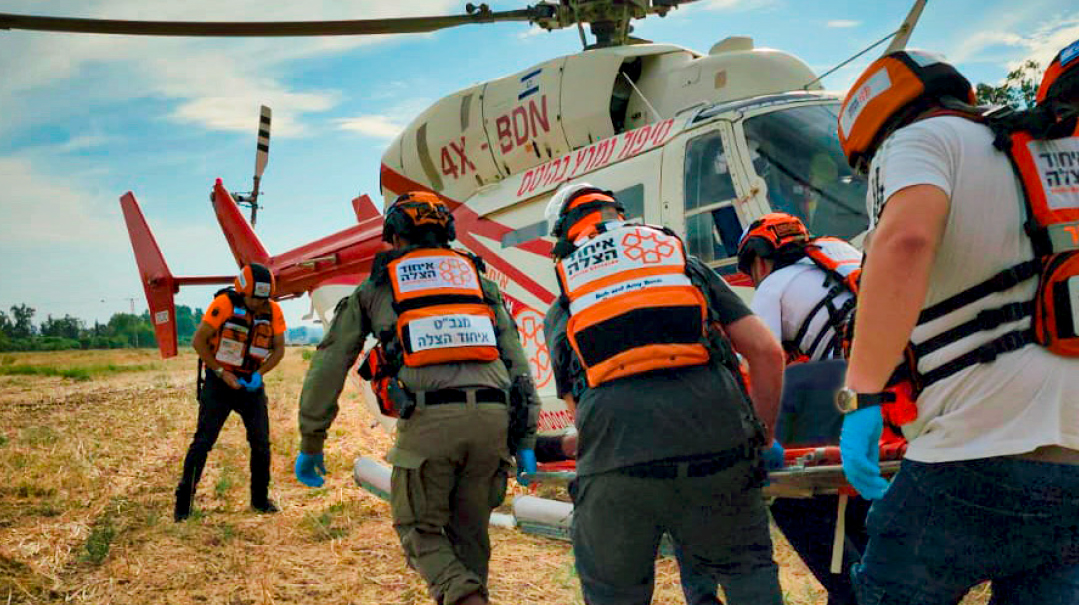Angels Under Fire
| January 23, 2024The terror and carnage of October 7 couldn’t stop United Hatzalah’s volunteers from heading into the war zone

Photos: ArtScroll/Mesorah Publications, AP Images
On October 7, 2023 — Simchas Torah 5784 — over 1,000 volunteers of United Hatzalah willingly put their lives in danger and entered the war zone to save countless lives under fire. Miraculously, every single one of the volunteers who drove down south that morning returned home alive. Each one of the “angels in orange” has a story, and those stories are now being shared in a soon-to-be-released book
IT
was the most wrenching decision Hatzalah COO Dovi Maisel had ever made. How could he send his volunteers into the war zone when the first rule of emergency aid is to stay out of the line of fire? “I had to do it,” he told me, noting that the other national emergency crews were told not to enter any live-fire situation. “I had to allow them to go and save Jewish lives. Because that’s what we do.”
By Motzaei Yom Tov of Simchas Torah, the rest of us learned that Hamas had attacked the country from the air and the sea and through the border fence. We learned that they had gone from kibbutz to kibbutz slaughtering anyone they were able to kill, and that they had taken hundreds of hostages. We learned that they had attacked the people who had attended a music festival near Kibbutz Re’im.
We learned that they had infiltrated the cities of Sderot and Ofakim.
And we understood that something happened on that day that had changed the world as we knew it.
During the first week of the war, I was contacted by United Hatzalah founder Eli Beer, who was still reeling from the incredible mesirus nefesh of his national team of Hatzalah volunteers. Eli knew it was a story that had to get out, and so, I picked up the gauntlet. I put everything else in my life on hold as I began interviewing the volunteers who had gone down south to save the lives of their fellow Jews, without weighing the pros and cons of their own safety.
And so emerged the story of the angels in orange.
Angels in Orange is a book about one never-to-be-forgotten day — a day that displayed both the best and the worst of mankind, about human animals and modern-day heroes. And most importantly, about the kind of ahavas Yisrael that sends people to a war zone to save a Jewish life.
Amazingly enough, the Master of the World rewarded this incredible group by making sure that every single volunteer who traveled down south to save lives lived to tell the story.
Some were shot at; others encountered terrorists; one was almost crushed by a tank. But every one of those heroic tzaddikim somehow made it home alive.
Three months into this war, the collective memory of those first days starts to get fuzzy, even as it’s become clearer than ever that little makes sense according to the rules of nature: It doesn’t make sense that the army ignored the intensive training exercises that Hamas was conducting on the Gaza beaches just across the border — in full view of Israel — even though the soldier lookouts kept warning their higher-ups about the maneuvers. It doesn’t make sense that a billion shekels of hi-tech was breached by a few tractors, or that there was an utter collapse of one of the most advanced military and security establishments in the world, capable of pinpointing and liquidating enemies around the globe, yet utterly blinded on that dark day.
And it doesn’t make sense that during the early hours of Simchas Torah morning, there was a very limited police presence on the highways between the southern city of Sderot and the rest of the country, and had the terrorists continued onward, as was their initial plan, they might have swept through the countryside reaching all the way to Jerusalem. Instead, they killed, tortured, maimed, stole, kidnapped, and kept themselves occupied committing unfathomable evil — too busy to continue onward even though the roads were open and they could have gone anywhere they wanted.
There are countless stories of other such miracles. Stories of terrorists shooting at people at point-blank range — and nothing happened to them. Stories of terrorists choosing one particular person and telling them to run — allowing them to live for no apparent reason.
So many miracles and so much pain — side by side.
None of us likes reading about massacres and murder, yet that is exactly what happened to our nation. Not in the distant past. Not 1,000 years ago. Not 500 years ago.
Now. In our time. To us. And we need to know what happened to our brothers and sisters in Eretz Yisrael on Simchas Torah 2023.
Oops! We could not locate your form.







